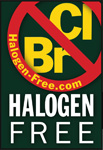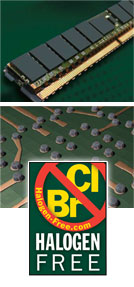Indium5.8LS Halogen-Free Testing
Much of the electronics manufacturing industry agrees that the best method for determining the halogen content of a flux or solder paste is through the use of an oxygen bomb combustion followed by ion chromatography (IC) test. Particularly for solder paste, there is still some disagreement as to the best way to conduct this test. When running an oxygen bomb combustion, you cannot have any metal in the test chamber (i.e. solder powder). Therefore, the four proposed methods are all based on the EN 14582 Test Method with variations only in pre-preparation of the solder paste.
- Testing the raw flux: The flux is obtained prior to the manufacturing process in which it is mixed with the powder or the flux can be separated from the powder if already in the paste form. Approximately 1g of the flux is placed into the oxygen bomb crucible and the test is run and followed by IC. This is the simplest of all proposed procedures but does not assess the real concern which is the amount of halogens remaining on the circuit board following reflow. However, assuming that none of the halogen volatilizes (safe assumption), then you can calculate the total halogens based on the flux residue remaining after reflow (typically 40-50%). The percentage of flux residue can be determined gravimetrically (weigh the flux, reflow it, and weigh the remaining residue) or through TGA.
- Testing the reflowed flux residue: A sample of solder paste is reflowed in an aluminum pan and approximately 1g of the residue is scraped into the oxygen bomb crucible. The advantage of this test is that you don’t have to run an additional calculation since the IC results will assess exactly the amount of halogens in the flux residue. The challenge with this test is that it is based on the assumption that the flux residue is homogeneous. In reality, the halogen content in the flux residue near the solder joint may be different from the residue near the outside of the flux pool. Also the process of scraping the residue may remove other materials, particularly if this test is adapted to testing residue on the PCB.
- Reflowing the flux in the oxygen bomb crucible: A sample of the flux is placed into the oxygen bomb crucible and reflowed. This test method ensures no additional handling of the flux residue is necessary. However, since the oxygen bomb requires a fairly precise quantity of approximately 1g of material, it is challenging to predict exactly how much flux will volatilize during reflow. Also, handling of the crucible is critical. Contamination, such as finger prints, can create artificial spikes in halogen content that is not related to the flux.
- Reflowing the solder paste in the oxygen bomb crucible: A sample of the solder paste is reflowed in the crucible, the coalesced ball of solder is removed, and the test is conducted. This test was proposed because there was some concern in the industry that the halogen content would be different if reflowed paste is tested rather than flux. Running this test is extremely difficult because of contamination concerns, predicting the right quantity of solder paste to reflow (solder paste is 10% flux, 50-60% of that flux volatilizes, and you need 1g of residue), removing the bead of solder paste is not easy if it doesn’t perfectly coalesce.
Indium5.8LS: Halogen-Free No Matter How it is Tested
Test Method #1 (Raw Flux):

Test Method #2 (Reflowed Flux):

Test Method #3 (Reflowed Flux in O2 Bomb Crucible):

Test Method #4 (Reflowed Paste in O2 Bomb Crucible):

Note on Reporting Limit Courtesy of EMT: The Method Detection Limit (MDL) is defined as the estimate of the minimum amount of a substance that an analytical process can reliably detect. A MDL is analyte-and matrix-specific and may be laboratory-dependent.
The Reporting Limits (RL) are the minimum levels, concentrations, or quantities of a target variable (e.g., target analyte) that can be reported with a specified degree of confidence.
The MDL is the level where the procedure can see if the analyte is present or not present. It is more of a qualitative measurement. The RL is the level where the procedure can start to measure the amount of the analyte. It is a quantitative measurement. The MDL study is analyzed annually while the RL is usually the lowest point in the calibration curve and therefore doesn't change annually like the MDL. These limits will change proportionally based on the amount of sample analyzed and if any dilution was performed on the sample. For example, if the sample is diluted 5X, then the MDL and RL are 5X higher.















